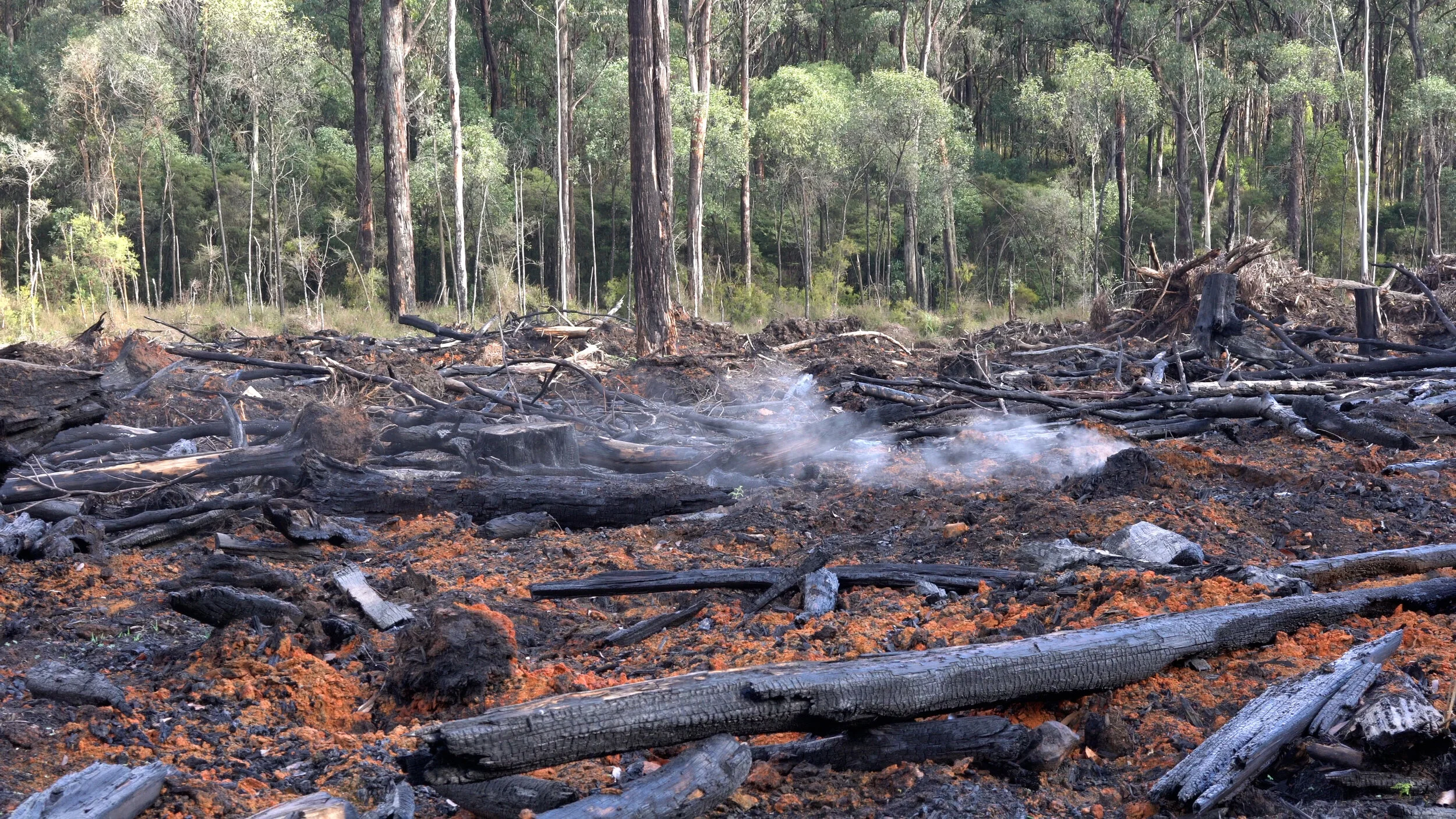State government backed logging putting rural communities in greater bushfire risk
By Stephanie Chen
The first time Nic Fox walked onto the edge of the Pats Corner coupe, a deforested site just two kilometers from the nearest Victorian town of Big Pats Creek, she collapsed into tears.
As the vice-president of Warburton Environment, Fox had always been dedicated to the conservation of the Mountain Ash forests in Victoria’s Central Highlands, an endangered ecosystem found only in Victoria and Tasmania. But this time she felt more than just grief for what once stood in place of the barren landscape she now calls the “hellscape.”
She also felt immense dread for the people in her community because in the past 6 years, surmounting scientific evidence has shown a direct link between logging of native wet forests and increased wildfire severity and frequency.
At the same time, industrial native forest logging projects have been inching ever closer to the borders of rural Victorian, New South Wales and Tasmanian towns which already exist in some of the world’s most dangerous fire zones.
That increased bushfire threat became a close reality for Fox’s home in Warburton earlier this year, when the Victorian Government backed enterprise VicForest, chose to log just 3km away.
“I had been researching and reading a lot about how logging increases risk of fire severity and of crown fires [where fires leap from tree top to tree top], already thinking it’s ridiculous that the government continues to mandate logging near settlements knowing the science and risk is there.” Fox said.
“But when [a colleague] sent me an email asking me if I knew they were going to log on Mount Bride, and you can go out my backdoor to see Mount Bride, just on the other side, which as the crow flies it’s only about 3 km away, is the coupe that was up for logging in February/March this year… and I just went no no no that’s way too close to my home.”
“There was this visceral realisation of the increased fire risk we were going to be put in and having just experienced the 2019/2020 Black Summer bushfires, to have already lost so much… It is criminal.”
Despite the understandable gut-assumption that logging should lead to less fires (what’s there left to burn if it’s been cleared away?), the link between logging of native wet forests and increased fire severity and frequency is backed by a long-history of research stretching back decades, across Canada, the USA, Patagonia and Australia.
However, it’s also true that even science can rarely offer a perfectly black or white argument. In opposition, VicForest frequently cites a single major paper written in 2013 which denies the link between logging and increased fire risk. It was co-authored by researchers and logging industry employees and led by Dr Peter Attiwill, a now retired researcher from the University of Melbourne.
As immediately as the wheel of science is capable of turning, the 2013 paper was refuted by Senior Professor Ross A. Bradstock and Dr Owen Price, both from the University of Wollongong, who conducted the original research which produced the data used in Dr Attiwill’s study.
For many, such as Distinguished Professor Jamie Kirkpatrick, from the University of Tasmania and an Order of Australia recipient, the new generation of research by multiple institutions and research groups provide “clear and overwhelming evidence that logging makes forests more flammable” as he explains why in a piece for The Age.
“In logged forests, the body of evidence shows increased flammability begins in the first 10 years after logging or fire and continues for about another 30 years” said Professor Jamie Kirkpatrick.
“Dense plant growth occurs in forests growing back from either logging or fire… [which can] create a "fuel ladder" to the treetops. Growing trees in young forests create greater fire hazard for decades.
“The wind speed on hot days increases because of the lack of a tree canopy, wind speed is a key factor in creating extreme fire conditions.
“Climate change is already resulting in more extreme fire danger days, and the evidence is that native forest logging makes things worse.”
Pleading the case
Despite this scientific consensus and research, Fox says the Victorian government has ignored community attempts for meetings or discussions. A few months after one of Australia’s worst fire seasons, 59 new coupes were approved for VicForest to log in and near the Gippsland region.
Professor David Lindenmayer, lead researcher at the Fenner School of Environment and Society at the Australian National University and an Australian Officer of the Order, says many pleas have also been made by the scientific community to the government which are being ignored.
“We’ve been recommending there should be no logging within several kilometers of towns because of the potential [increased flammability] dangers.” Professor Lindenmayer said.
“People from Noojee, not too far from Warburton, have sent VicForest letters of complaints about the dangers posed to their communities by logging so close.
“The newest body of work, all that material has been made available to them, there’s been a whole lot of letters written to the Victorian Government over long-periods of time.”
While the majority of native forests across Victoria is under public ownership and managed by the government, there is one other major player. The judiciary system, who most recently sided against VicForest in a landmark case about illegal logging.
“From my understanding there’s another 5 court cases going on. You can imagine why VicForests doesn't want to admit there’s problems because obviously there’s potential liabilities [to their business model] here.” Professor Lindenmayer said.
“So the actions of the VicForest are not necessarily the actions of an organisation that's sympathetic to the interests of rural communities.”
Premier Daniel Andrews, Leader of Victoria’s Labor government, has previously addressed the issue of native forest logging.
“Today we announced an end to old growth logging. And that by 2030, all native timber logging will cease.” Premier Daniel Andrews declared on November 7, 2019 via Facebook.
At the time the decision was applauded by many Victorians as progressive. For those in the know however, 2030 was a very deliberate year.
The true cost
Adam Fletcher, a conservationist from Toolangi, says the primary motivating force behind native forest logging is to meet the demands of the Wood Pulp Agreement Act 1996. It is a deal Fletcher describes as a “heartbreaking sellout” of Australian natural resources to international corporate interests.
“The majority of native forests logged goes to the Maryvale paper mill in Gippsland which is owned and run by Australian paper, but [Australian paper] is actually owned by the Japanese company Nippon paper.”
“Lots of people think it’s going towards quality timber goods but of the native forests logged yearly, an average of 80%-87% will become pulp for Nippon paper.
“In 1996, under liberal state government, when Premier Geoff Kennett signed the Wood pulp Agreement Act, he gave these forests away for 30 plus years just to make paper.”
Those 34 years come to an end in 2030.
Even purely on economic terms, this has become a costly deal for the Victorian tax-payer. In the 2018-2019 financial year VicForest was paid $18.7 million in “other income from Victorian government entities.” This scraped VicForest into their reported $3 million profit.
Furthermore in recent surveys, 80% of rural and regional respondents in Victoria stated they no longer supported the continuation of native forest logging.
Of those who are still pro-native forest logging, and even those who are not, community members are concerned over potential losses of jobs in the forestry industry. It’s a source of conflict that Fox believes does not have to exist.
“The media like to pitch it as the greenies against the jobs when ultimately it's not us and them. We're all in this together.” Fox explained.
“More than 90% of timber industry workers have shifted to plantations and there is already a plan for the remaining 9% left working in the native forest industry sector to transfer over by 2030. Why not as soon as possible?
“There's already $120 million put aside. There are small mills around here that don't have the saws that will take plantation timber, well let's help them to get those saws so that they can take plantation timber and process that.
“Native forest logging is economically unsustainable too… what happens to the jobs in a few years time when there’s nothing left to log.”
In 2018, a Forests (Wood Pulp Agreement) Repeal Bill was introduced in Victorian Parliament but was promptly and quietly voted down.
And so for constituents like Fox, the fight for this battle continues.
“There are just so many different possibilities but we need to act now, not by 2030 as announced by Daniel Andrews, but we need to act like we’re in an emergency now because we are.” Fox said.
“I want people from Melbourne, which is just an hour and a half away, to come out and see what's happening in our backyard… it's your water supply as well, it's your place of sanctuary that’s being destroyed.
“Until I know that our precious state forests are no longer being cut and are protected, I won’t stop and I won’t be silenced.
“This is a matter of protecting my community, my family and my home.”
Hon. Lily D'Ambrosio, Minister for Energy, Environment and Climate Change, Minister for Solar Homes office has been contacted but no comments have been provided.
The concerns surrounding native forest logging increasing fire threats is shared by many rural communities in NSW (along the south and north coasts, Eden Bay and Batemans Bay), Tasmania (Geeveston, Maydena, Derby, Southport and Dover) and Victoria (Warburton, Big Pats Creek, Toolangi, Healesville, Noojee, Orbost, Mallacoota and Cann River).





